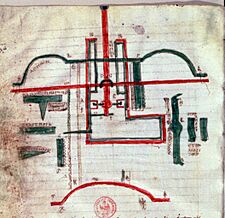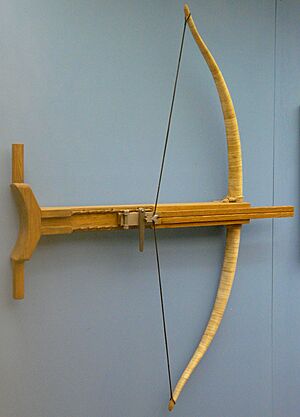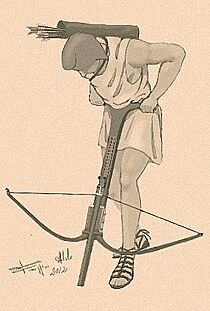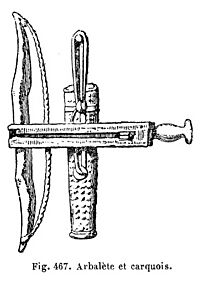Gastraphetes facts for kids
The gastraphetes (pronounced gas-tra-FEH-tes) was a special type of crossbow used by the Ancient Greeks. Its name means "belly-releaser" or "belly shooter." This is because of how it was loaded.
This ancient weapon was described by a Greek writer named Heron of Alexandria around the 1st century AD. He wrote about it in his book Belopoeica. Heron said the gastraphetes was an early version of the catapult. This means it was invented a long time ago, possibly before 420 BC. Unlike later crossbows, you didn't pull the string up. Instead, you pushed a part of the weapon down using your stomach.
Contents
What Was the Gastraphetes?
Heron's book gives us a good description and even a drawing of the gastraphetes. This information came from an earlier engineer named Ctesibius. The gastraphetes got its power from a composite bow. This type of bow is made from different materials, like wood, horn, and animal sinew, to make it very strong.
To load the gastraphetes, you would place your stomach against a curved part at the back of the weapon. Then, you would push down. This method allowed a person to use much more strength than with a regular hand-held bow. This made the gastraphetes very powerful.
We don't have any actual gastraphetes weapons found by archaeologists. But Heron's descriptions are so good that people today have been able to build working copies of them.
Bigger Versions of the Gastraphetes
Larger versions of the gastraphetes were called oxybeles. These were huge weapons used during siege warfare to attack cities. Later, the ballista was invented. Ballistas were even more powerful and eventually replaced both the oxybeles and the gastraphetes.
When Was the Gastraphetes Invented?

For a long time, many historians thought the gastraphetes was invented in 399 BC. They believed it was created by a team of Greek builders for a ruler named Dionysius I of Syracuse.
However, newer studies suggest that the historian Diodorus Siculus was actually talking about a mechanical arrow-firing catapult, not the gastraphetes. Since Heron said that larger, stand-mounted catapults were inspired by the hand-held gastraphetes, it means the gastraphetes must have been invented sometime before 399 BC.
We can guess the invention date might be even earlier, before 421 BC. Another Greek writer named Biton wrote about two advanced types of gastraphetes. He said they were designed by an engineer named Zopyrus of Tarentum. Zopyrus might have created these weapons for battles around 421 BC to 401 BC. This means the original gastraphetes must have been known even before that time.
Other Ancient Crossbows
Besides the gastraphetes, other hand-held weapons similar to crossbows existed in the ancient world. Historians still debate the exact names for these weapons.
- Roman writers like Vegetius mentioned weapons called arcuballista and manuballista or cheiroballistra. Most experts agree these were hand-held mechanical weapons.
- The Roman commander Arrian wrote about Roman cavalry (soldiers on horseback) training to fire a mechanical hand-held weapon while riding.
- Stone carvings from Roman Gaul (modern-day France) show people using crossbows for hunting. These carvings are from the 2nd century AD. The crossbows look very much like the ones used in the Middle Ages. They even had a special "nut lock" to hold the string. These were also composite bow designs.




